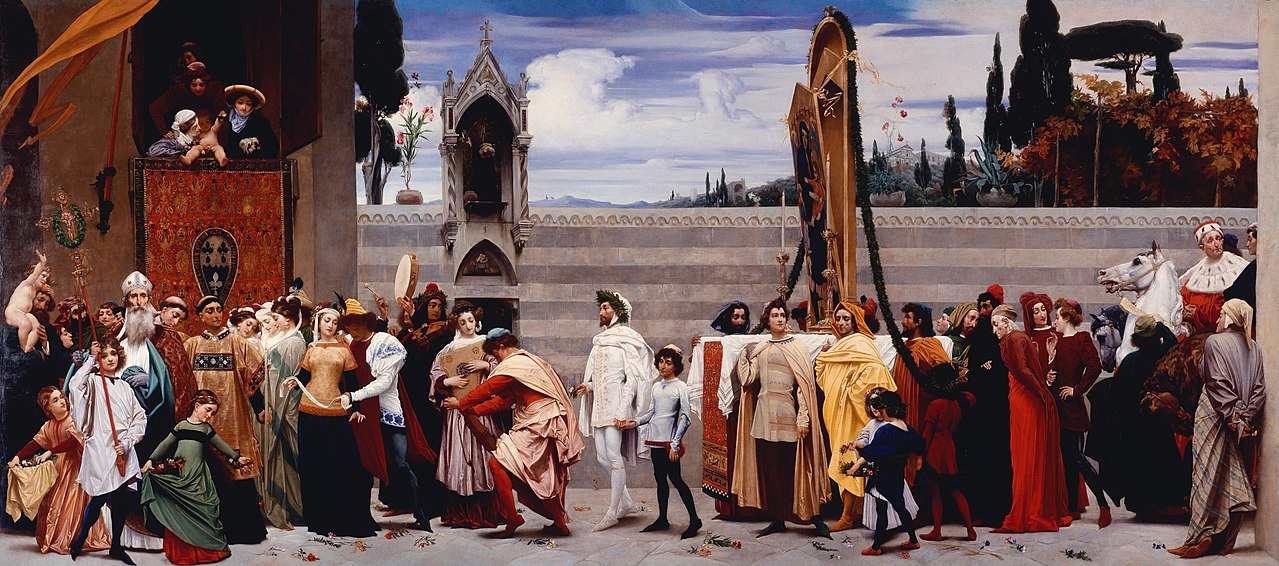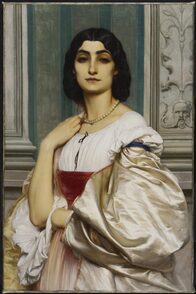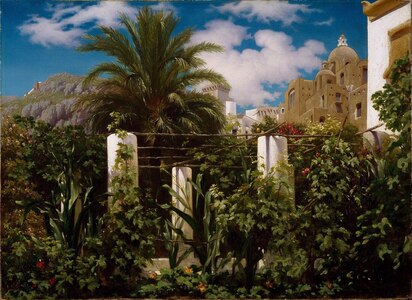Frederic Leighton (1830-1896), was one of the most famous British artists of the nineteenth century. He spent much of his early years on the continent and travelled extensively. His career was always cushioned by his family wealth, with his father paying him an allowance throughout his life. He moved to Paris in 1855, but for more than two years before he had been in Rome, devoting most of his time to painting the picture of Cimabue's 'Madonna being carried in Procession through the Streets of Florence', which was his first major work and the first he submitted to the Royal Academy Summer Exhibition. He settled in England in 1859.
In 1864 Leighton became an associate of the Royal Academy and in 1878 he became its President (1878–96)
In 1864 Leighton became an associate of the Royal Academy and in 1878 he became its President (1878–96)
Cimabue's Celebrated Madonna or Madonna Carried in Procession through the Streets of Florence was Leighton's first major work. The painting was bought by Queen Victoria who noted in her diary: "There was a very big picture by a man called Leighton. It is a beautiful painting, quite reminding one of a Paul Veronese, so bright and full of light. Albert was enchanted with it—so much so that he made me buy it." The painting is on long-term loan from Buckingham Palace to the National Gallery where it can be seen above the staircase in the Sainsbury Wing.
Note: The Madonna depicted is actually not by Cimabue, but instead it is the Rucellai Madonna by Duccio, an error attributed to Vasari which was corrected in 1889.
Note: The Madonna depicted is actually not by Cimabue, but instead it is the Rucellai Madonna by Duccio, an error attributed to Vasari which was corrected in 1889.
BG Windus owned a colour sketch of Cimabue's Celebrated Madonna (as seen in the header). Discover the history of the sketch after it was sold by BG Windus here.
|
BG Windus owned several other works by Leighton. The Windus Papers - Turner, Ruskin and the Pre-Raphaelites - sold at Bonhams on 24 March 2009 contain four autograph letters signed ("FredLeighton"), to Windus, requesting, in vain, that he lend A Roman Lady (La Nanna) for exhibition and asking that he allow Stella and Tolla to remain at the Hogarth Club for a while, but declining his commission to paint a replica of another [Roman female] head ("...I never undertake repetitions as I am not confident of my power to obtain the same effect twice - and have already been obliged to decline several commissions for duplicates of the very head which you wish me to repeat...") From Capri and St James's Street, 1859 |
For information on Roman Lady or La Nanna click here
|
It was in 1862 that he exhibited 'The Odalisque,' at the Royal Academy
Described at the time as: a beautiful girl leaning on the wall, with her head on her arm, with an embroidered scarf round her waist, and a large peacock's fan on her left arm, gazing dreamily at a white swan in the water at her feet. The swan is apparently expecting something that the girl does not feel inclined to give him, and, to judge by the ruffled character of his plumes, is likely to make himself unpleasant in case of failure. Behind the girl's head is a tangle of bushes and flowers, while two temples or mosques are seen in the distance. And more recently as: sensual depiction of a standing woman, the Odalisque (from the Turkish 'Odalik' meaning chambermaid) is accompanied by a swan and dressed in a costume of rich eastern fabric and drapery. This painting is part of a category of nineteenth century European images in the manner of Ingres and Delacroix where non-western women are depicted in 'exotic' or 'sexualised' poses. |
Windus sold works from his collection at several auction houses. These are the records for the Leighton works sold at Christie's:
1859 Christie's auction records: two finished sketches for the picture of Romeo and Juliet Exhibited at the Royal Academy; Head of an Asiatic Very powerfully painted and Samson, blind A fine sketch for the large picture in progress.
1862 Christie's auction: Samson and Delilah ital a sketch for the large picture; The garden of the inn at Capri Exhibited at the Royal Academy, 1861; Stella A beautiful study from life, painted at Rome, and never before exhibited and Tolla - the companion Equally fine; also painted at Rome.
1868 Christie's auction following the death of BG Windus in 1867: Lovers, The Reaper - the companion, A Turk, seated, holding a pipe and The Odalisque A work of the highest excellence. Exhibited at the Royal Academy, 1862.
1859 Christie's auction records: two finished sketches for the picture of Romeo and Juliet Exhibited at the Royal Academy; Head of an Asiatic Very powerfully painted and Samson, blind A fine sketch for the large picture in progress.
1862 Christie's auction: Samson and Delilah ital a sketch for the large picture; The garden of the inn at Capri Exhibited at the Royal Academy, 1861; Stella A beautiful study from life, painted at Rome, and never before exhibited and Tolla - the companion Equally fine; also painted at Rome.
1868 Christie's auction following the death of BG Windus in 1867: Lovers, The Reaper - the companion, A Turk, seated, holding a pipe and The Odalisque A work of the highest excellence. Exhibited at the Royal Academy, 1862.

Leighton House in London, the home of Sir Frederick Leighton is now a museum.
To find out more about Sir Frederick Leighton go to Leighton House





